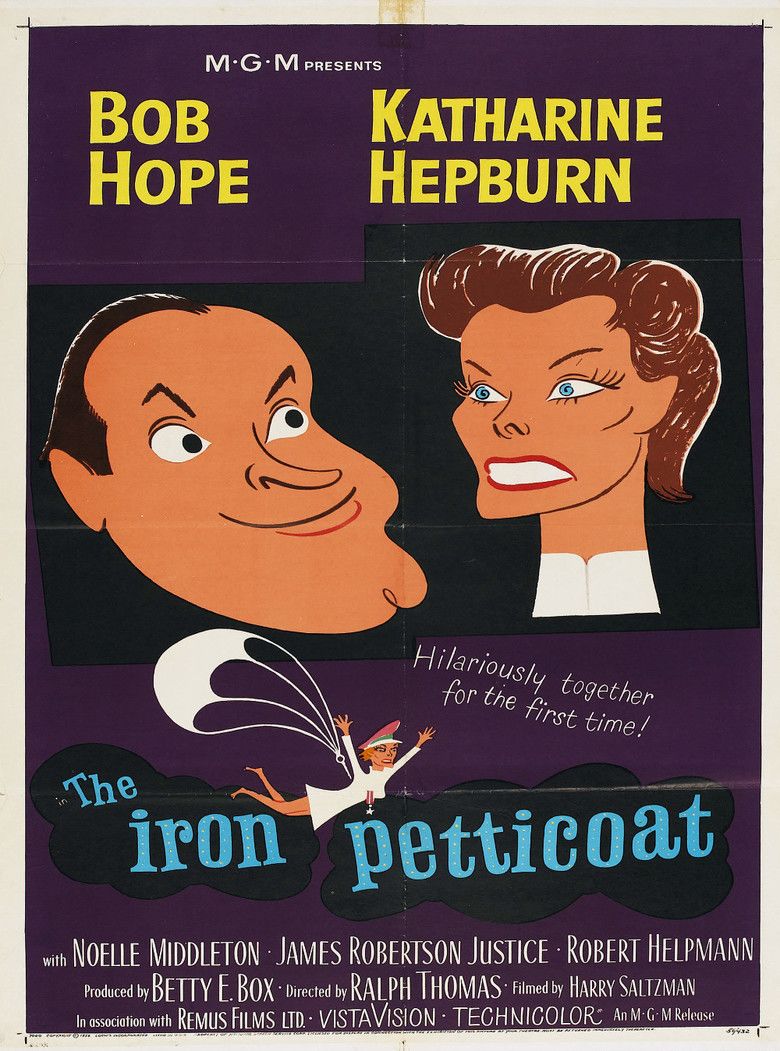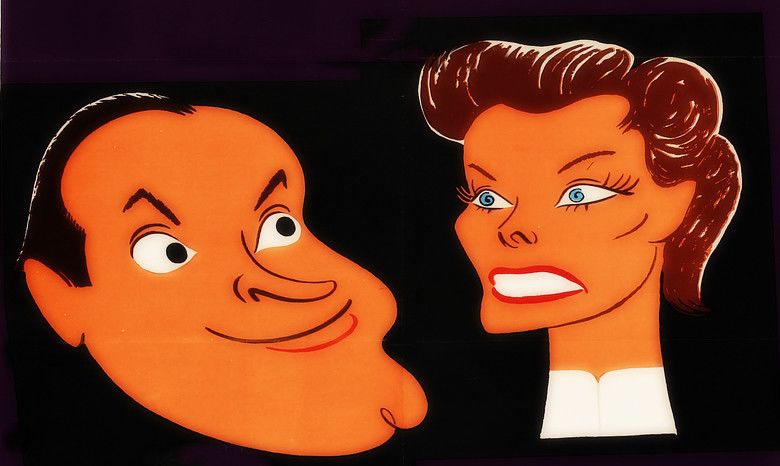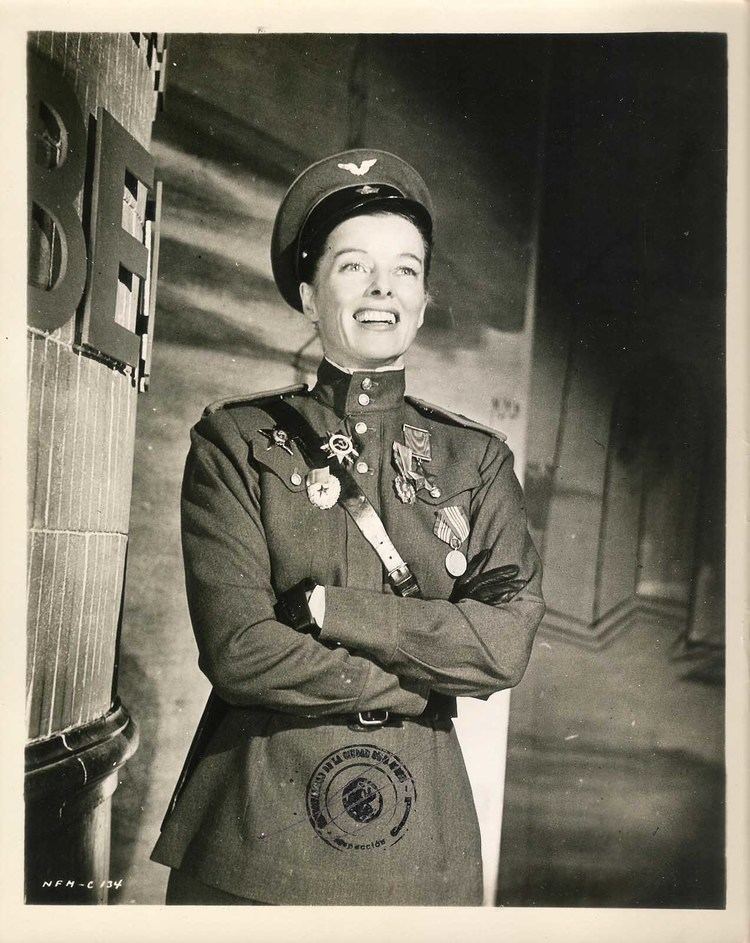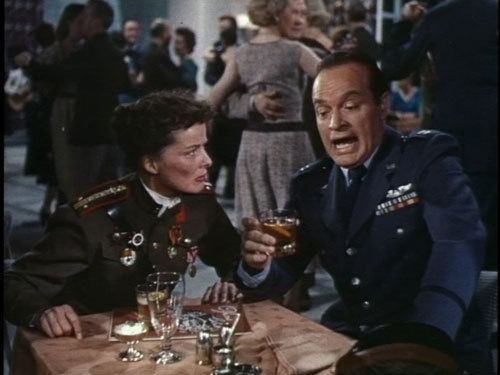The Iron Petticoat
5.4 /10 1 Votes5.4
Duration Country United Kingdom | 5.2/10 IMDb Genre Comedy Language English | |||||||||||||||||||||||||||||||||
 | ||||||||||||||||||||||||||||||||||
Release date 30 June 1956 (1956-06-30) (Berlin International Film Festival)1956 (1956) (London, premiere) Cast (Major Charles "Chuck" Lockwood), (Captain Vinka Kovelenko), (Lady Connie Warburton-Watts), (Colonel Sklarnoff) Similar movies Child 44 , Dr. No , Bridge of Spies , Salt , Leninland , Tsar to Lenin Tagline Bob and Kate...Simply Great | ||||||||||||||||||||||||||||||||||
The Iron Petticoat (aka Not for Money) is a 1956 British Cold War comedy film starring Bob Hope and Katharine Hepburn and directed by Ralph Thomas. The screenplay by Ben Hecht became the focus of a contentious history behind the production and led to the film's eventual suppression by Hope. Hecht had been part of the screenwriting team on a similar themed Comrade X (1940).
Contents
- Plot
- Development
- Bob Hope
- Rewriting the Script
- Shooting
- Clash Between Hecht and Hope
- Critical reception
- Box office
- Subsequent history
- Proposed follow up
- References

Hepburn plays a Soviet military pilot who lands in West Germany and, after sampling life in the West in the company of Hope's Major Chuck Lockwood, is converted to capitalism. Subplots involve Lockwood trying to marry a member of the British upper class and Communist agents trying to get Hepburn's character to return to the Soviet Union.

The main story borrows heavily from Ernst Lubitsch's Ninotchka (1939), starring Greta Garbo, and very closely resembles Josef Von Sternberg's Jet Pilot with Janet Leigh as the Russian pilot and John Wayne as the US Air Force officer, which completed principal photography in 1950 but was not released until 1957, after The Iron Petticoat. Jet Pilot was also inspired by real life incidents of Cold War pilot defections.

Plot

Captain Vinka Kovelenko (Katharine Hepburn) lands a Russian jet in West German territory, to the surprise of US armed forces, who take her prisoner. She is neither on a mission nor defecting, however, just upset about a personal matter back home.

Capt. Chuck Lockwood (Bob Hope) is eager to leave for London and visit his wealthy fiancée Connie (Noelle Middleton). A superior officer named Tarbell (Alan Gifford) cancels his furlough, ordering Chuck to sell the Soviet aviatrix on everything that is good about America and convince her to permanently come over to their side. The colonel even dangles a $100,000 bonus cheque made out to Vinka, if Lockwood succeeds.

Vinka is pursued by her former lover, Ivan (Robert Helpmann), an engineer. She shows no interest in Chuck and is just as determined to sell him on Russian virtues as he is on influencing her. He describes her as cold and unappealing, but when Connie makes a surprise visit, Vinka strolls into Chuck's room wearing little else but a pajama top and her military medals. Connie becomes increasingly angry, more so when she finds out that Chuck is not as well-off financially as he has pretended to be.
Vinka begins to dress more and more in an enticing manner. One night at a Russian restaurant, comrades come to kidnap her. A sleeping potion meant for Chuck ends up in Tarbell's drink instead. Connie is also mistaken for Vinka in a cloak room and taken captive.
The Russians misunderstand Vinka's intentions and charge her with treason. Chuck leads a daring aerial escape and they end up falling in love. Money does not matter as much to Vinka as it does to Connie. As she and Lockwood are leaving for America, a Russian agent runs up, offering her the $100,000 cheque. She declines, but Lockwood grabs it.
Development
The original screenplay Not for Money was written by Ben Hecht, from a story by producer Harry Saltzman. The two men formed a company to make the film, Benhar. Hecht wrote the film specifically as a vehicle for Katherine Hepburn.
Hepburn was pleased by the original script, and personally selected Ralph Thomas as the director, because she liked his movie Doctor in the House (1954). She contacted Thomas and the latter's producer Betty E. Box while they were making Doctor at Sea and they agreed to take part. "I had no idea what dramas were to descend on us as a result of that call," wrote Box later.
"We accepted the job because Miss Hepburn agreed to do it and because we liked the Ben Hecht script," said Thomas. Box and Thomas were under contract to the Rank film organisation but were allowed to make outside films. "They [Rank] turned very sour," wrote Box. "But we stuck to our guns - we wanted to work with Hepburn, on top of which we were to be paid much larger fees than those guaranteed under our Rank deal."
The film was a US-British co-production, with finance provided by MGM and Romulus Films.
Bob Hope
According to Box, Hepburn originally envisioned the male lead being played by Cary Grant, William Holden or James Stewart. However they struggled to cast it. "There was difficulty in finding a top star to play opposite Hepburn," wrote Box, "an example of the male chauvinistic attitude which baulks at the leading lady's part being better than the man's."
Bob Hope got hold of the script and wanted to play the role. It was unlike anything Hope had done in the past but he said he wanted to work with Hepburn, and would play the character as written.
"We all thought the idea quite mad at first," said producer Betty E. Box of Hope's casting. "Then we all had second thoughts and said, 'Why not?' And I must say the first of us to see that it made sense was Katie."
According to his biographer, Hope also saw the opportunity to get away from the United States at a time when a scandal was tarnishing his reputation as a family man. Hope had been embarrassed by the publication of a "tell-all" by former lover, Barbara Payton, and advised by close confidantes to leave the United States until the bad press had subsided.
The film project marked the first time that Hope had worked outside the United States, and in the country of his birth. It had also been more than fifty films since he worked outside Paramount.
At one stage Kay Kendall was meant to support Hope and Hepburn.
Rewriting the Script
Filming was to begin in November but Hope was not available. He did not arrive in London until 7 December 1955. He then told Box and Thomas he wanted to pull out of the film, saying he was unhappy with the script. Hepburn and Hecht agreed to make changes to keep Hope on the film. Hope also turned the script over to his own gag writers to tailor it to his style, as was his usual practice. Many of Hepburn's best scenes were cut, and the title was changed from Not for Money. Hope had intended to change his role from a debonair leading man to that of his usual wise-cracking comic. Hepburn considered her pairing with a co-star steeped in comedy routines as a "challenge."
Shooting
Hope and Hepburn had a wary relationship during the production as she was aware that the film was being remade into a typical Hope comedy, leaving her aspirations to do a Garbo-like role nearly untenable. Privately, Hepburn characterised Hope as "the biggest egomaniac with whom I have ever worked in my entire life." She also considered the film as "a cheap vaudeville act " with her appearing as the "stooge."
"It ended up as a Hope comedy," recalled Thomas. "He had seven writers, she had none. I can't really say I directed the picture. I refereed it. Each star would come on the set each day with a different piece of script. Each was happy with the scene he had - until they compared notes!"
Donald Sinden, then a contract star for the Rank Organisation at Pinewood Studios, had a permanent dressing room in the same block as Hepburn's. He said, "Katharine Hepburn was delightful and most professional, but what was deemed by some to be 'professional' can also be called 'temperamental' by others. I happened to be on the set of The Iron Petticoat while Miss Hepburn was blowing off steam about something in a professional/temperamental manner. Bob Hope came to the rescue and with his superb sense of humour said to her, "If you don't behave yourself. I'll tell everyone that you are Audrey Hepburn's father!"
A difficult time in the UK was compounded by a worrisome eye infection, but Hepburn, who had made a commitment to the film due to the entreaties by good friend Robert Helpmann, played the "good trooper" and completed her obligations, although for years she would not talk about the film. Her later recollections of The Iron Petticoat were of an unlikely pairing of lead actors, trapped in the wrong roles. She recalled that Hope thought her sense of humour was basically "zilch."
Production took place primarily at the Pinewood Studios but also utilised unique background locations such as Buckingham Palace and Piccadilly Circus, as well as air bases in the UK. Although the plot involved a defecting military pilot, only a minimum of aircraft appeared in the production, with the use of a Republic F-84F Thunderstreak as a stand-in for the ubiquitous MiG-15 jet fighter, the staple of 1950s Iron Curtain air forces, including that of the Soviet Union. The spurious "red star" markings appear on both the F-84F and C-47 to convert them to their Soviet look-alikes. When Kovelenko's MiG is escorted into West German airspace, two USAF North American F-86D Sabres intercept it. A Douglas C-47 Skytrain (as its counterpart, the Soviet Lisunov Li-2) is used for the return to Russia, while a Boeing Washington B.1 bomber and Avro Anson transport aircraft also appear, albeit mainly as backdrops.
Clash Between Hecht and Hope
The Iron Petticoat was released through Metro-Goldwyn-Mayer in the American market.
Hope, whose company controlled US rights as one of the film's producers, cut 12 minutes from the version released in the UK. Hope's cutting prompted Hecht to take a full-page ad in The Hollywood Reporter which stated:
My dear partner Bob Hope: This is to notify you that I have removed my name as author from our mutilated venture, The Iron Petticoat. Unfortunately your other partner, Katharine Hepburn, can't shy out of the fractured picture with me. Although her magnificent comic performance has been blowtorched out of the film, there is enough left of the Hepburn footage to identify her for her sharpshooters. I am assured by my hopeful predators that The Iron Petticoat will go over big with people 'who can't get enough of Bob Hope.' Let us hope this swooning contingent is not confined to yourself and your euphoric agent, Louis Shurr.
As Hecht told journalist Mike Wallace in a 1958 interview, "The movie was written for a lady, Miss Katharine Hepburn, and ended up instead as a role for the hero, Mr. Bob Hope. Miss Hepburn was removed from it by fifty percent. I got irritated and took my name off it – it had nothing to do with the movie I wrote."
Hope replied with an open letter which stated:
My dear Ex-Partner Ben: You once wrote The Front Page, and now you've followed it up with the back page … I am most understanding. The way things are going, you simply can’t afford to be associated with a hit. As for Kate Hepburn, I don’t think she was depressed with the preview audience rave about her performance.... Bob 'Blowtorch' Hope.
On the US release, the film's credits ended up calling it "Based on an Original Story by Harry Saltzman." Saltzman often joked that his first motion picture production was the only Bob Hope film that failed at the box office. The latest release by TCM, however, features a large screen credit: "Screenplay by Ben Hecht."
Critical reception
The Iron Petticoat was a critical failure when it was released beginning in December 1956 in the United States. Bosley Crowther of the New York Times, noting Hecht had disavowed his work on the film, summed up many of the critical appraisals: "'The Iron Petticoat,' which encloses Katharine Hepburn and Bob Hope, is about as inflexible and ponderous as the garment its title describes. And everybody connected with it might be forgiven for trying to claim an out." He also wrote: "Miss Hepburn's Russian affectations and accent are simply horrible, and Mr. Hope's wistful efforts with feeble gags to hold his franchise as a funny man are downright sad. The notion of these two characters falling rapturously, romantically in love is virtually revolting. If this was meant to be a travesty, it is."
In an interview in 1972, Italian actress Rossella Falk said that Garbo was "unhappy with Hepburn because she made a movie called 'The Iron Petticoat'. The film was a parody on 'Ninotchka', and Garbo thought the Hepburn film was the worst film that she had ever seen."
Box office
According to MGM records, the film was a modest box office success, earning $1,260,000 in the US and Canada and $125,000 elsewhere. Low production costs resulted in a profit of $109,000.
Subsequent history
The film's distribution rights were divided between Hope's company, which controlled the Western Hemisphere, and the UK company Romulus Films, which held the Eastern Hemisphere, including the UK. MGM received a 10-year licence for the Western Hemisphere in 1955.
After its initial theatrical release, The Iron Petticoat had only two public screenings in the US, at the Museum of Modern Art and the American Film Institute, both sanctioned by Hope Enterprises after MGM's rights expired in 1970. Apparently withheld because of Hope's unhappiness over the public controversy with Hecht, it had never been shown on US television, and has never been released on home video there, though it is readily available in the UK, where rights are currently controlled by ITV.
Turner Classic Movies indicated in April 2012 that it has entered into an agreement with Hope Enterprises for a 10-year licence for US and Canadian TV rights and negotiated to release The Iron Petticoat on Blu-ray and DVD in North America as part of its TCM Vault Collection video line. TCM aired the film on 29 November 2012.
Proposed follow up
After filming ended it was announced Saltzman, Hecht and Thomas would make an adaptation of The Imaginary Invalid starring Robert Helpmann. However this film was never made.
References
The Iron Petticoat WikipediaThe Iron Petticoat IMDb The Iron Petticoat themoviedb.org
